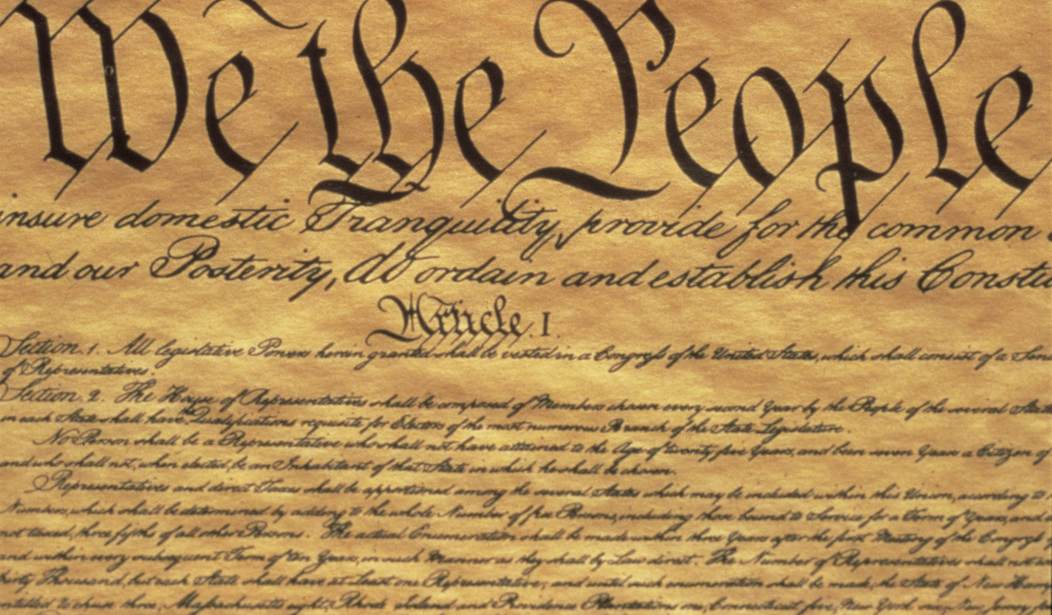A simulated Article V Convention of States is scheduled for Friday, September 23. The event will last from 8:45am – 4:45pm EST, and will take place in Colonial Williamsburg, Virginia. The convention will be streamed live online at http://www.conventionofstates.com/livestreamrsvp and will also be available for download after it’s complete. Supporters hope that seeing how the process unfolds in real time will create momentum to hold an actual Article V Convention to amend the U.S. Constitution.
Article V of the Constitution provides two mechanisms by which the Constitution can be amended. The first is via the Congress, which is how all 27 amendments have been passed in American history to date. The other is via a Convention of States. The article language is quite simple:
The Congress, whenever two thirds of both houses shall deem it necessary, shall propose amendments to this Constitution, or, on the application of the legislatures of two thirds of the several states, shall call a convention for proposing amendments, which, in either case, shall be valid to all intents and purposes, as part of this Constitution, when ratified by the legislatures of three fourths of the several states, or by conventions in three fourths thereof, as the one or the other mode of ratification may be proposed by the Congress; provided that no amendment which may be made prior to the year one thousand eight hundred and eight shall in any manner affect the first and fourth clauses in the ninth section of the first article; and that no state, without its consent, shall be deprived of its equal suffrage in the Senate.
There are several Article V attempts currently ongoing. One is an application for a Balanced Budget Amendment. In May 2016, Oklahoma became the 28th state to pass a resolution applying to Congress for a Convention under Article V to consider a balanced budget amendment. Article V requires 2/3 of the various states to apply, which means that 34 states must pass a resolution requesting a convention. Supporters believe that within then next year or two, a strong possibility exists that 6 more states will make such requests, reaching the 2/3 threshold of 34 states.
The organizers of the simulation event believe that an Article V convention is our last, best hope to rein in a federal government that is out of control. The Executive Branch enforces laws selectively, Congress too often fails to stand up to the President, and the Supreme Court has too often made flawed decisions that did not live up to the intent of the Constitution (see Kelo, Obamacare, etc).
From the Convention of States website:
“Despite this year’s election chaos, I feel optimistic about the future of our nation. Why? Because a massive group of dedicated Americans—citizens and state legislators alike—are taking the bold action the Founders intended us to take at a time such as this. ” – Mark Meckler
There are many detractors of an Article V Convention, but this simulation is intended to alleviate many of those fears. There has been a sea of misinformation spread about the dangers of a Convention of States, from both sides of the aisle. The most often cited fear is that of a runaway constitutional convention that radically alters the very structure of our Constitution. Some have even claimed that such a Convention could lead to the return of segregation, or even slavery.
The very language of Article V, however, is clear. This is not a constitutional convention. This is a convention of states. There is a big difference. The Framers of the Constitution were familiar with the concept, with as many as 30+ interstate conventions having been held prior to the ratification of the Constitution. An Article V Convention will, by its very definition, be limited to the subjects petitioned by the various states.
The Balanced Budget Amendment application is a good example of how a convention would be limited in what could be considered. Once 34 states apply to Congress, a convention is required to be called by Congress to consider only what is in the applications. Congress tells the states to send delegates to a convention to write an amendment. Neither Congress nor the state legislatures actually write the amendment – that’s reserved for the delegates to be done at the convention.
Remember, once an amendment is written, either by Congress or by delegates to a Convention, it must be ratified by 3/4 of the states. That means 38 states must ratify the amendment, or it never becomes law. To put that in more succinct terms: it only takes 13 states to block any attempt to change the Constitution. It’s DIFFICULT to change the Constitution. It’s supposed to be difficult. That’s the point. So the claims that a runaway convention could radically alter our government are not founded in reality.
On the other hand, public polls show strong support for a balanced budget amendment, a term limits amendment, and doing anything to curtail the power that’s been accrued to the elites in Washington, D.C.
This statement perfectly encapsulates why an Article V Convention is necessary: “This is not a partisan issue. Washington, D.C., will never voluntarily relinquish meaningful power—no matter who is elected. The only rational conclusion is this: unless some political force outside of Washington, D.C., intervenes, the federal government will continue to bankrupt this nation, embezzle the legitimate authority of the states, and destroy the liberty of the people. Rather than securing the blessings of liberty for future generations, Washington, D.C., is on a path that will enslave our children and grandchildren to the debts of the past.”
The late Antonin Scalia participated in a debate on Article V in 1979, in which he destroyed the narrative of a runaway convention:
The founders inserted this alternative method of obtaining constitutional amendments because they knew the Congress would be unwilling to give attention to many issues the people are concerned with, particularly those involving restrictions on the federal government’s own power. The founders foresaw that and they provided the convention as a remedy. If the only way to get that convention is to take this minimal risk, then it is a reasonable one.
I have not proposed an open convention. Nobody in his right mind would propose it in preference to a convention limited to those provisions he wants changed . Regardless of the issue-say, a constitutional amendment on abortion-its supporters would want a convention that considers that issue and nothing else; or one that considers only the particular features of the Constitution that they do not like, but precludes consideration of those features they do like. I think there is nobody, except maybe one or two anarchists, who would sincerely want an open convention for its own sake, to expose the whole system to possible change.
By allaying fears of a runaway convention, organizers of the simulated convention hope to show American voters that they do have the power to control the government, as it’s supposed to be – not the other way around. A nice bonus will be that when an Article V Convention is called, Americans will have to sit up and take notice. In a nation where 20% of recent college graduates think that Judge Judy is on the Supreme Court, a real time lesson in civics will go a long way towards restoring self governance as intended by the Founders.
Once an amendment is proposed and ratified via a Convention of States for the first time, it may very well be that a rapid series of other amendments will follow. Let’s see if that logjam can be broken, and power returned to the people.










Join the conversation as a VIP Member